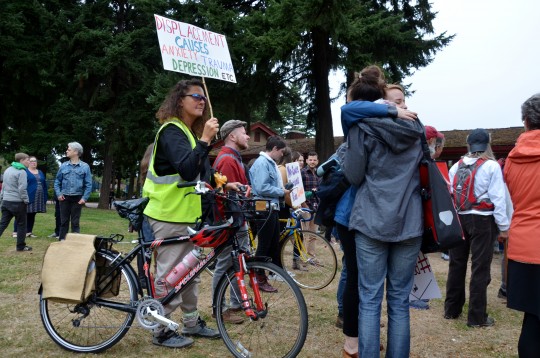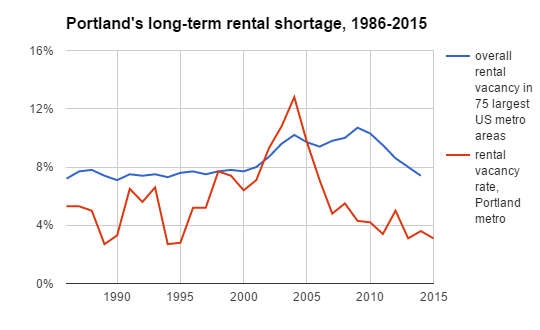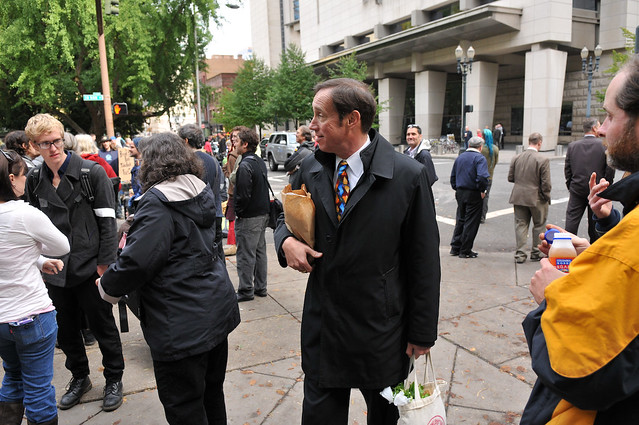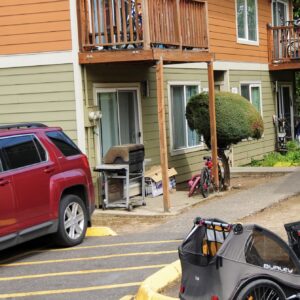
(Photo: M.Andersen/BikePortland)
After years of fighting, a “grand bargain” on affordable housing passed Oregon’s legislature this week. But it won’t begin shaping Portland’s bikeable neighborhoods until after the city council takes action of its own.
Representatives for Mayor Charlie Hales and his council colleague, Housing Commissioner Dan Saltzman, say that plans to do so are already underway.
Any city plan seems certain to include some level of “inclusionary zoning,” a measure that could require that up to 20 percent of units in some new buildings be sold and/or rented at discount prices to people who make less than 80 percent of the median income. (As of 2015, that 80 percent figure means that a family of three that makes less than $52,950 would qualify for the reduced-rate units.)
But many questions remain. In which neighborhoods would the rule apply? Will developers be allowed to build higher, or exempted from expensive requirements such as auto parking, to make up for their losses from those discounted rents? Will inclusionary zoning be coupled with other changes such as re-legalizing duplexes or garden apartments or charging a “linkage fee” on all new development? Developers will also have the option to get out of the inclusionary zoning requirement by paying into a city affordable housing fund; how high will that fee be?
All of those decisions will be made by cities like Portland, probably in the next few months.
Because migration to Portland boomed during the Great Recession just as the construction rate plummeted, the city’s population has grown 79 percent faster than its housing supply.

(Data: Census Bureau.)
That’s left the metro area with one of the nation’s lowest rental vacancy rates and made soaring real estate prices and rents the single hottest issue in the current mayoral election.
Advertisement
Oregon’s House of Representatives approved a Senate bill Thursday that removed the “preemption” in state law that has banned cities from using inclusionary zoning. Gov. Kate Brown is expected to sign.
Saltzman’s chief of staff, Brendan Finn, said in an email Thursday that his boss has laid out a plan for “a community-wide data driven discussion that would include but would not be limited to members of the development community, as well as affordable housing experts and advocates.”
“Dan introduced a resolution at council Feb. 10,” Finn said. “Now that preemption is to be lifted and signed into law, we can get started on a process for crafting a policy for Portland.”
Hales spokeswoman Sara Hottman said the mayor is also ready to start work.
“Mayor Hales has instructed all involved city bureaus to develop plans for an effective Portland implementation of the new law,” Hottman said in an email. “Commissioner Saltzman, in charge of the Housing Bureau, has been instrumental in passing the bill, and will be overseeing the implementation.”
A repeal of the state’s ban was the Portland city government’s top legislative priority in Salem this year.
Affordability advocates gear up for local debate

(Photo: J.Maus/BikePortland)
The Portland advocates who’ve been pushing for repeal of the state ban said they’ll be shifting their work to City Hall, in part because they think a successful policy in Portland will create political support for a future effort to fully remove Salem’s regulation of housing price controls. Here’s the word from Vivian Satterfield, deputy director of OPAL Environmental Justice Oregon:
This is obviously a big day for OPAL Environmental Justice Oregon and the Oregon Inclusionary Zoning Coalition. We’re proud to have put this issue on the table in Salem and to have convened a large and powerful statewide coalition that together, brought about this historic victory for housing opportunity. That being said, there are key pieces of the legislation that need to be fixed in future years at the state level. OPAL and other partners of the Coalition, namely those organizations representing people of color and working families, expect to be at the relevant policy tables to craft a local IZ policy that maximizes the use of the tool in its current form. We have already initiated these discussions with Commissioner Saltzman’s office and we look forward to working with the future Mayor of Portland as well. Demonstrated efficacy of any inclusionary zoning policy both at the City of Portland and other jurisdictions ready to adopt their own IZ policy will undoubtedly support future efforts to seek a full repeal and local control.
For three years now, we’ve been exploring how you can’t have a truly bike-friendly city without affordable proximity. Depending on how this new state law gets enacted and what other changes come along with it, this could be a very important moment in making sure Portland’s bikeable neighborhoods don’t slip permanently out of reach for most Portlanders.
— Michael Andersen, (503) 333-7824 – michael@bikeportland.org
BikePortland can’t survive without paid subscribers. Please sign up today.







Thanks for reading.
BikePortland has served this community with independent community journalism since 2005. We rely on subscriptions from readers like you to survive. Your financial support is vital in keeping this valuable resource alive and well.
Please subscribe today to strengthen and expand our work.
This is the Portland that I’ve loved all these years, for a minute, I thought it was slipping away. I’m sure there’s more work to be done, but to have IZ laws reworked is a positive step for the people of Portland.
“Will developers be allowed to build higher, or exempted from expensive requirements such as auto parking, to make up for their losses from those discounted rents?”
So far the answer to both those questions seems to be “no”, at least so far. In order:
The City recently published the draft of the 2035 Central City plan, which will regulate development in Downtown, the Pearl, South Waterfront, the Lloyd District, etc. While there was a lot of attention paid last year to height increases at a handful of sites in Downtown, almost none of those sites are receiving an increase in allowable Floor Area Ratio (FAR). Indeed, the amount of FAR that is automatically obtainable is being scaled back throughout the Central City, by the elimination of most of the existing FAR bonuses. (Right now extra FAR be gained by providing bike locker rooms, green roofs, and a whole host of other desirable things). The only remaining bonus in most of the Central City will be for providing affordable housing. However even if developers choose to do so, they won’t be able to build anything larger than what is currently allowed. So while the city might claim that they’re giving bonuses for affordable housing, they’re only doing it by taking away existing entitlements.
Secondly, the Planning & Sustainability Commission will be looking at revisions to parking requirements in Northwest on Tuesday next week. The current zoning in the Northwest Plan District doesn’t require any parking spaces to build, superseding the citywide requirements. The proposed revisions will eliminate this, requiring developers to build to the regulations adopted for much of the rest of the city in 2013. There is no language in the proposal that would allow this to be waived when affordable housing is built.
Does anyone know if it is theoretically possible for the city’s IZ ordinance to allot buildings additional floor area ratio (i.e. total building size) beyond that allowed under these comp plan limits?
Yes. The 2035 Central City Plan is a technically an amendment to the Comp Plan. I believe (though I’d have to check) that the 1988 Central City Plan was an amendment to the 1980 Comp Plan. And FAR limits in the North Pearl and South Waterfront were set by amendments to the 1988 Central City Plan.
However given that the regulations of the new Central City Plan aren’t likely to take effect until late 2017 or early 2018 (almost 11 years after work began on the plan) any talk of amending *that* is likely a discussion about changes that will take effect in the 2020s.
The city rushed out the minimum parking increase faster than that, why couldn’t they enact other zoning changes at the same pace?
I don’t know why planning takes so long in Portland, but I know that it does. I would be very surprised if the process to upzone any significant area of land took less than a couple of years.
You need to remove the 4 years of Sam Adams’ administration from the equation. That was a planning black hole, from which nothing, even time itself, can escape. In fact, I think it took a year to recover from Sam, so you should subtract 5 years from the actual timeline.
Did you know that Gil Kelley coined the term “Portland Plan” when Tom Potter was mayor? That was supposed to be the comprehensive plan update. Then Sam took us on his 4 year vision quest, which was quickly thrown in the trash bin after Charlie got elected and DLCD said “update your damn comp plan, Portland.” How many periodic review extensions have we gotten? 3? 4? If nothing else Charlie should get credit for bringing us back into compliance with state land use laws. Considering that we basically had to start over in 2012 it has been a pretty Herculean effort.
I don’t know much about the internal politics of the City, but it seems a bit of a reach to blame it all on Sam Adams. The N/NE Quadrant Plan was adopted in October 2012, very near the end of his term. The resolution that approved it stated that the Central City 2035 was “anticipated to be completed in 2015”. Here we are in 2016, and the current timeline is to have it completed by the end of the year.
Thank you four pointing out the NW PDX parking requirements.
It’s kind of appalling when you look at how much stronger the protections are for car housing than for human housing: http://pdxshoupistas.com/minimum-parking-requirements-can-neutralize-inclusionary-zoning/
Great news! Also great that the unbelievably short-sighted proposal to expand the urban growth boundary is dead. Now we need to have a discussion on what tactics to improve affordability we should use. Ideally, all of them, but we should start by removing all minimum parking requirements for new developments.
I’m delighted to hear this news coming from Salem; the news from POrtland, not so much. This city needs IZ NOW, not in 3-4 years when studies and committee hearings and stakeholders meetings have run their course. The longer IZ rules take to implement, the faster Portland turns into into San Francisco; a great city to live in ONLY if you’re rich.
San Francisco has inclusionary zoning, and it doesn’t seem to have prevented it from turning into San Francisco….
It only works if it’s in place when buildings are being built. SF has managed to mostly suppress development with restrictive (de facto exclusionary) zoning. If we’re going to get ahead of the housing supply problem, we need to implement IZ immediately AND up-zone enough close-in land to open the floodgates of building.
Where does it work?
prevented what exactly?
IZ is designed to increased the availability of affordable housing, not skew housing prices as a whole. in fact, one of the primary criteria fo effective inclusionary zoning is a lack of negative impact on other development.
http://smartgrowth.umd.edu/assets/documents/research/knaapbentolowe_2008.pdf
Well, I was responding to a post that described San Francisco as “a great city to live in ONLY if you’re rich”, and suggested that Inclusionary Zoning hasn’t worked to prevent that outcome in that city.
The Executive Summary of the document you linked to has this description of the effects of IZ on house prices:
“We also found that housing prices in cities that adopted inclusionary zoning increased about 2-3 percent faster than cities that did not adopt such policies. In addition, we found that housing price effects were greater in higher priced housing markets than in lower priced markets. That is, housing that sold for less than $187,000 (in 1988 dollars) decreased by only 0.8 percent while housing that sold for more than $187,000 increased by 5.0 percent. These findings suggest that housing producers did not in general respond to inclusionary requirements by slowing the rate of single family housing construction but did pass the increase in production costs on to housing consumers. Further, housing producers were better able to pass on the increase in costs in higher priced housing markets than in lower priced housing markets.”
If we can extrapolate that to Portland, I’m not looking forward to housing prices rising 2-3 percent faster than they already are.
don’t confuse cause and effect. i suspect that regressive land-use policy, lack of financial regulation, and regressive tax subsidies have more to do with loan/home appreciation than IZ.
I was quoting from a link that you provided….
IZ is more likely to be implemented in areas with housing scarcity. is it any surprise that prices tend to rise more in areas with housing scarcity?
IZ is one action that is expected to only have a modest impact on housing inequity. rescinding the discriminatory and exclusionary land use policy that carpets wealthy central portland would have a much greater impact.
Interesting…Progressives have run this city for decades. And Progressives are complaining about housing costs.
Business-friendly establishment democrats are progressives? I guess I’m not a progressive then.
Progressives’ clout comes in somewhere behind moneyed patrons and personal ambition. It goes as far as what’s necessary to win elections and not a step further; beyond that line, they’ll kick you to the curb.
The mayor and every city commissioner lives south of Killingsworth and west of 39th in tony, low density residential neighborhoods. Think about it.
I don’t quite get IZ zoning. Doesn’t it simply mean the folks who aren’t in the affordable housing essentially end up paying for the ‘gap’? Also, will income be checked each year to qualify for affordable housing? I have friends that make waaaayyy too much qualify for affordable housing, but they did qualify when they first applied years ago @ a lower income. One of my friends also have a 2 bed affordable unit where the second bedroom is his dining room?! Lots of loopholes….
Y’all ready for this? Here is how inclusionary zoning is going to work in a place like Portland, as I have come to understand it.
Your theory that the other people in the building would pay more was my first theory too — that’s how I thought IZ worked until last year. And it would be true if tenants were stupid. But tenants are not in general stupid, at least about their rent. If a developer puts up a building that was zoned for IZ and tries to cover the costs of the cheap units by charging extra for one of the expensive units, then tenants will go find some other unit in another building that doesn’t have to help cover the losses from a cheap unit.
So what IZ actually does is reduce the amount of money that a developer can make from a building that has been zoned for IZ. If developers were stupid, this would simply reduce developer profits. But developers are not in general stupid, at least about their money — once land is zoned IZ, they are willing to pay less for it.
So this is the main effect of IZ: *land that has been zoned IZ goes down in value.*
Great, you say! Land is a little cheaper, a few units have lower rent, and we are all a little more happy.
But here’s the real tradeoff: cheaper land is also less likely to redevelop. Here’s why.
Infill redevelopment takes place in exactly one situation: when the value of the land beneath a building exceeds the value of the building itself plus the cost of deconstructing/demolishing it. Or in the form of an equation:
L > B+D
Where L is the land, B is the building and D is the demolition cost.
SO to recap, IZ reduces L, the cost of land, down to L minus one. But
L-1 < B+D
For example, If I want to buy an old car wash and put up 50 apartments and a Los Gorditos, then I need to buy the car wash building first. But I can only afford to pay as much as the land is worth, because I’m not going to use the car wash as a car wash. If the car wash is worth more as a car wash than it is as vacant land, then somebody else will outbid me and keep it as a car wash.
If that happens, then no 40 market-rate apartments, no 10 reduced-price apartments and no Los Gorditos. Portland can probably live without another Los Gorditos but it is in extreme need of more apartments at every price. (Even rich-people apartments are useful because they give rich people a place to move into instead of pricing middle-class people out of their places, and so on until the poorest person winds up in a tent. Plus rich-people apartments gradually rot into middle-class apartments over time.)
So … by reducing the price of land, inclusionary zoning slightly slows the growth of housing supply, which drives up prices very slightly everywhere in the market in exchange for its benefits (10 lower-middle-class families that can still afford to live at 50th and Division).
Are there very many properties that are really close to the margin between developing and not developing? Nah, not really. The version of IZ that Oregon just passed isn’t going to drive down the price of the land very much, so not very many buildings will be deterred.
Also: a city can take actions that drive *up* the price of land, like reducing the minimum parking requirement or increasing the allowable size of the buildings on top. If a city does that at the same time as it zones for IZ, then everybody wins. (Except people who really hate big buildings or really love parking garages.) This is a pretty ideal scenario from my perspective, and it’s one that is possible, but not guaranteed, under the law Oregon passed.
Fascinating. Thank you! This is incredibly useful.
Fantastic comment. Love the math. You lost me at the Los Gorditos because I haven’t eaten breakfast yet and any mention of Los Gorditos makes me hungry.
This Is why I like the tiny home and prefab back yard unit model. I don’t think most people appreciate how expensive new construction really is. And if we want this new construction to not look hideous it’s more expensive still. There were several periods in my adult life when a cozy shed like stricture would have been fine. And the cost and time needed to implement expanded units would be brief.
I get your logic, but I question the assertion that tenants are either stupid (rent in new buildings) or not stupid (rent in older buildings). The rental market is currently crazy and people are looking everywhere for a unit. I’m currently looking for a place and new buildings are the only place where there is a vacancy with any chance of being filled without rushing to turn in an application during the first few hours a vacancy comes up in an older building.
The result? Rents everywhere are being driven up. Managers of older buildings see the value increase based on the extremely high demand and raise rents, to which most people respond by paying them as those are the most affordable rents. People who can’t spend all their time looking for rental units and can afford it, go with a newer, or new, building.
Unfortunately, with IZ, the latter folks will be directly subsidizing the rents of 1 out of 5 of their building neighbor. Buildings with required occupant subsidies will have to charge more to make up the loss, which puts more pressure on the existing housing stock. We all pay indirectly to a small degree, but the biggest cost will an inevitable slow down in development.
I’m not confident the City will get IZ “right” the first, second, or even third tries. I fear that developers will choose to sit it out and move to other development markets as a result. It will take the City years (thank you endless planning processes) to get good data on development trends to make corrective measures. This is my biggest worry with IZ.
IZ is not the whole answer. As the article pointed out, Portland needs to loosen up zoning rules to permit more kinds of development such as duplexes and courtyard apartments – as just two examples.
I’m currently finishing my basement to add two bedrooms. Not really an ADU but something like it that might be an option for a lot of people. The return on investment is around 2-3 years or 1 year and a huge pain in the ass if you do the work yourself as I’m doing. And hopefully the end result will be 2 more people living in a bike-able neighborhood in N Portland come spring time.
I just wanted to say that I like the term “affordable proximity.” I haven’t heard (noticed?) it before. It had a lot of power.
I am not going to pay a lot for this apartment in the most desirable part of town!
With appolgies: https://www.youtube.com/watch?v=-V9LBZmYnYs
Any update on the pace of new apartment construction (number of permits, of starts, etc) now and expected for the coming years?
With new buildings popping up like mushrooms, I an curious if the housing shortage might be resolved or at least ameliorated in the next few years simply by growing supply?
The Fall 2015 Barry Apartment Report has this to say:
“Based on the current shortage of units and the steady to increasing demand in the coming years, we do not expect vacancy rates to approach 5% for at least the next 12 to 18 months and possibly longer. When all is said and done, we expect 2015 and 2016 to bring 11,000 to 14,000 new units. This will help fill the demand from increasing population growth but will not fully make up ground from the lack of units built from 2008 to 2012. ”
Interestingly the annual number of units being permitted in multifamily buildings in the four county metro area is still below the peak of the mid 1990s. In the current boom a vastly larger number of units are being built in inner Portland, but not enough to compensate for the lower number of units being built in the periphery.
Move back to where you “googled” Portland in the first place. I am far more concerned with the current level of public education and apartments are not going to improve that. Tall apartment buildings are ugly. They block the SUN. It is the sheer number of people moving here that has driven the cost of housing up. Houses are really, really cheap in Detroit.
We should build a wall to keep them out. Razor wire fences are probably cheaper we only need armed guards to watch the entrances. That will keep them out!
Ah yes, “Native Portlanders Only.” Depending on your history horizon, this means nothing but wrens, towhee, osoberry, and red flowering currants.
It’s telling that this announcement has generated as much, if not more, discussion of height allowances as it has IZ itself.
Existing owners may be theoretically in favor of reducing housing prices, but in truth they are still more concerned with heights, aesthetics, and parking. Every single teardown is going to continue to generate a petition and protest. I don’t see that the inclusion of a below market-rate unit in the building is going to change that.
We should either let the builders build, or stop calling an expected supply/demand curve a crisis.
The teardowns that spark the most ire are replacing single-family houses with new, oversized, ugly single family houses within neighborhoods…I really think that there is less opposition to mid-rise buildings on arterials a la Division and Hawthorne. I’ll grant you that there is a lot of bellyaching about parking though. Implement a permit system or quitcha whining, I say.
There is quite a bit of opposition to the mid-rises on Division that I have observed coming from Richmond. The complaints do involve parking, of course, but a lot of neighbors seem to have issue with the buildings appearances, higher densities, and how they affect the street below. I believe much of the opposition stems from the fact that their neighborhood is rapidly changing and the mid-rises on Division are a very visible and obvious element of that change.
I for one, welcome the increased density and all the amenities that come with it.
A lot of people dislike the design of the buildings on Division. If the buildings were of higher quality, there’d be less opposition. I don’t know many people who are opposed to density in and of itself, it’s more the details of how we’re going about it.
What do you mean by “higher quality”? All new construction is required to adhere to current building code.
I mean better design. Division Design Initiative has some great ideas that can be implemented without loss of density if you want specifics.
I am familiar with DDI. Imposing an FAR limit along Division is their #1 priority. The DDI claims this is to reduce the “boxiness” of the buildings, but it will result in lowering the density. Currently, there is no FAR limit, so in practice, it is 4:1, based on a four-story building. The DDI is proposing “closing the residential floor area ratio code gap”, by lowering it, therefore lowering the density (since height limits remain the same.
Some of the other ones focus on building appearance and solar access, however adding an additional superficial design review to a non-historically-designated neighborhood corridor will only increase time costs for developers and result in less housing getting built. Considering vacancy rates are at an all-time low, creating steps to reduce development will only exacerbate the issue. Additionally, for half of the proposed guidelines, the city is already doing so using existing zoning.
Do not confuse building quality with code compliance. While they sometimes go hand in hand, it’s not a given. Code compliance typically has to do with life safety issues, not longevity.
Just FWIW, but 3330 Division Street won an AIA Portland Design Award last year. I think the building across 33rd Place by Works Partnership is pretty good too.
I happen to like the “boxy” modern designs. This is an architectural style that happens to be popular at the moment. I also happen to like historical design. This is the inherent problem with opposing “ugly” buildings, is that it’s completely subjective.
My comment was made in the context of the design of buildings turning people off to higher density. Design and quality are somewhat objective, but they can also influence how people feel about more development in their neighborhoods. I do not believe the construction on Division has been successful by that metric.
That may be the case. However, I don’t think imposing additional design criteria will help with that either. The end result will very likely be less new apartments getting built during a massive housing shortage. Additional design guidelines to appease a minority of neighbors will only cost developers additional time costs and many may not even bother building. The guidelines offer no benefits to the neighborhood and will only result in a further restriction in housing supply. I firmly believe that many of the neighbors are fighting the change in the neighborhood itself and not any one specific detail of that change. Increased density and mid-rise buildings are just currently an easy target.
The design issue is clearly more than the opinion of disgruntled neighbors — people have put an extraordinary amount of time and energy into the DDI, not to shut development down, but rather to encourage it to be better. That doesn’t sound like opposition to change to me.
I would think that, as a proponent of development, you would be happy about bringing more people into the “more development” camp, which efforts like this have the potential to do.
Grumbling that better design is too expensive is not an argument I find sympathy with in this development climate. If it can’t work now, when developers can pretty much name their price, when could it work?
Expanding the Design Review overlay zone to include Division (and Hawthorne and Belmont) is one of the proposals in the new Comprehensive Plan. There hasn’t been any organized opposition to it, so it will almost certainly happen. I personally support it, as I think we get better buildings in areas with Design Review than in areas without it. One example I like to use is the difference between the new Stadium Fred Meyer and the Hawthorne Safeway. The Fred Meyer went through Design Review. The original proposal was a piece of suburban garbage and the Design Commission pushed the architects to do a better building. The result is a project that massively improves W Burnside. The Safeway didn’t go through any kind of design review, and the result is regrettable.
That said, I don’t think Design Review would have resulted in significantly different result if the new buildings on Division had gone through the process. Unlike many other cities, Portland doesn’t really regulate architectural style in its Design Review process, and instead focuses on the ground level experience of the building. The really vibrant street level outside Salt and Straw etc is what Design Review strives for. So any neighbors who are clinging to the idea that Design Review will offer a way to stop future buildings similar to those already built are going to wind up very disappointed.
Yes, Division currently has an ‘m’ overlay for Main Street. This Design Review is intended to create a more urban street and bans things such as parking lots fronting the building. This I agree with. What I can’t support is creating an arbitrary architectural style review (which the DDI seems in support of). What should matter is how the buildings tie into the street below, not how they look or mass.
Many people who have lived in the neighborhood for decades disagree, and think it is important how buildings mass and look, for a variety of reasons. When increased density is represented by architecture that many residents dislike, it does not help expand support for more density.
Unless we are talking about racial/economic/minority displacement, people who have lived in the neighborhood for decades don’t get any more of a vote than newcomers. I for one, moved to the neighborhood because I specifically liked the changes on Division.
Why do some communities get a say and not others?
Racial and economic displacement was federal policy throughout the latter half of the 20th century and we are just now starting to attempt to reverse that trend. It is important for the victims of federal redlining policies to have their voices heard and elevated above those simply complaining about a building’s appearance, because the former group’s voice was silenced for so long.
I much prefer a more general statement that communities should have a voice in how they develop and transform. My statement would encompass the groups you highlighted, while also respecting the hard work that many have put in over the years building their neighborhoods.
I agree that “communities should have a voice in how they develop and transform”, however what I disagree with is the fact that many seem to imply that the people living in the neighborhood longer get more of a voice than newcomers. A single community is never unified under one opinion, often having many different voices and interests. Neighborhood association meeting attendees are not representative of the neighborhood as a whole – skewing toward longer-term homeowners – and we should not be giving preferential treatment to more tenured residents nor solely to homeowners. The people living in the apartments on Division get just as equal of a voice as a person living in an old bungalow for the past 20 years.
Not saying that you personally are expressing this opinion; this is just the impression I get from attending NA meetings.
I didn’t imply that anyone’s opinion should get more credit than anyone else’s, but I did, and do, say that we should respect the hard work that brought these communities to where they are.
I have attended lots of neighborhood meetings (NAs and others) and I have never seen short shrift given to the voice of anyone attending on the basis that they live in an apartment or are new to the community. Communities groups do generally reflect the opinions of those who choose to participate; it’s hard to imagine it being any other way. If a new resident in a new building wants to participate in the NA or in DDI or in any number of other community groups, they are welcome to, and can be very influential in the decisions made (as I’ve witnessed on many occasions).
You seem to be arguing that communities should have a voice in how they develop, and that everyone should be welcomed to participate in the process. I totally agree.
I tend to think that housing affordability is more a symptom of stagnate and/or lessening wages (when compared to inflation) for the lower and middle class for over 40 years, by in large the real estate markets as a whole have largely tracked with inflation for this time period – yes there are periods like Portland now which is not tracking with inflation- for right now, but by in large it’s the exception and not the rule.
Toss in the populations greater debt load (largely to compensate for the lack of wage increases), skyrocketing college tuition costs (most often even more debt) and the most populous generation in US history growing up and looking for housing you have the perfect storm for what is happening in Portland and other hot markets throughout the country.
If wages hadn’t stagnated, had college tuition costs followed inflation housing affordability wouldn’t be an issue for as many as it is now for many.
” If a developer puts up a building that was zoned for IZ and tries to cover the costs of the cheap units by charging extra for one of the expensive units, then tenants will go find some other unit in another building that doesn’t have to help cover the losses from a cheap unit.”
At less than 5% vacancy rates, that’s not likely to happy. Especially as most tenants, being “not stupid” will vie for the units in non IZ buildings, forcing those rental rates even higher.
“…a measure that could require that up to 20 percent of units in some new buildings be sold and/or rented at discount prices to people who make less than 80 percent of the median income.”
“Discount” prices should read “subsidized” prices. Someone needs to pay for the inclusion, and at the end of the day it will be the market rate renters.
Dan, Couldn’t agree more… the teardowns>>> monster homes really bothers a lot of people and may translate into dislike of increasing density in inner SE.
I think neighbors fighting to retain the character of their neighborhood is valid and shouldn’t be marginalized by the sudden realization that things have changed. Not everyone wants to live in NYC, Vancouver BC or even Seattle.
Rental vacancies fluctuate, ugly buildings and poorly designed communities are more permanent. Knee jerk reactions seldom yield good results.
I absolutely agree with this. The response the buildings on Division have also been very knee-jerk. The city’s comprehensive plan that allows for higher density on Division is not. Not to mention, “retaining the character of the neighborhood” means very different things to different people.
Would you characterize Division Design Initiative as being “knee jerk”? I think many residents have valid criticisms of the way Division has transformed, and dismissing them as being purely impulsive reactions shows you haven’t really listened to what people are saying. I don’t hear many saying we don’t want or need greater density, but rather they are unhappy about the particulars of how many of these new buildings were designed and built.
It looks like there may be an error in the article:
“Any city plan seems certain to include some level of “inclusionary zoning,” a measure that could require that up to 20 percent of units in some new buildings be sold and/or rented at discount prices to people who make less than 80 percent of the median income. (As of 2015, that 80 percent figure means that a family of three that makes less than $52,950 would qualify for the reduced-rate units.)”
The bill as enrolled reads: “197.309. (1) As used in this section:
(a) “Affordable housing” means housing that is affordable to households with incomes equal to or HIGHER than 80 percent of the median family income for the county in which the housing is built.”
This means, as of 2015, a family of three that makes $52,950 or MORE would qualify for the reduced-rate unit.There are additional tools within the bill that allow local jurisdictions to buy down units to 80% MFI or below, but not directly.